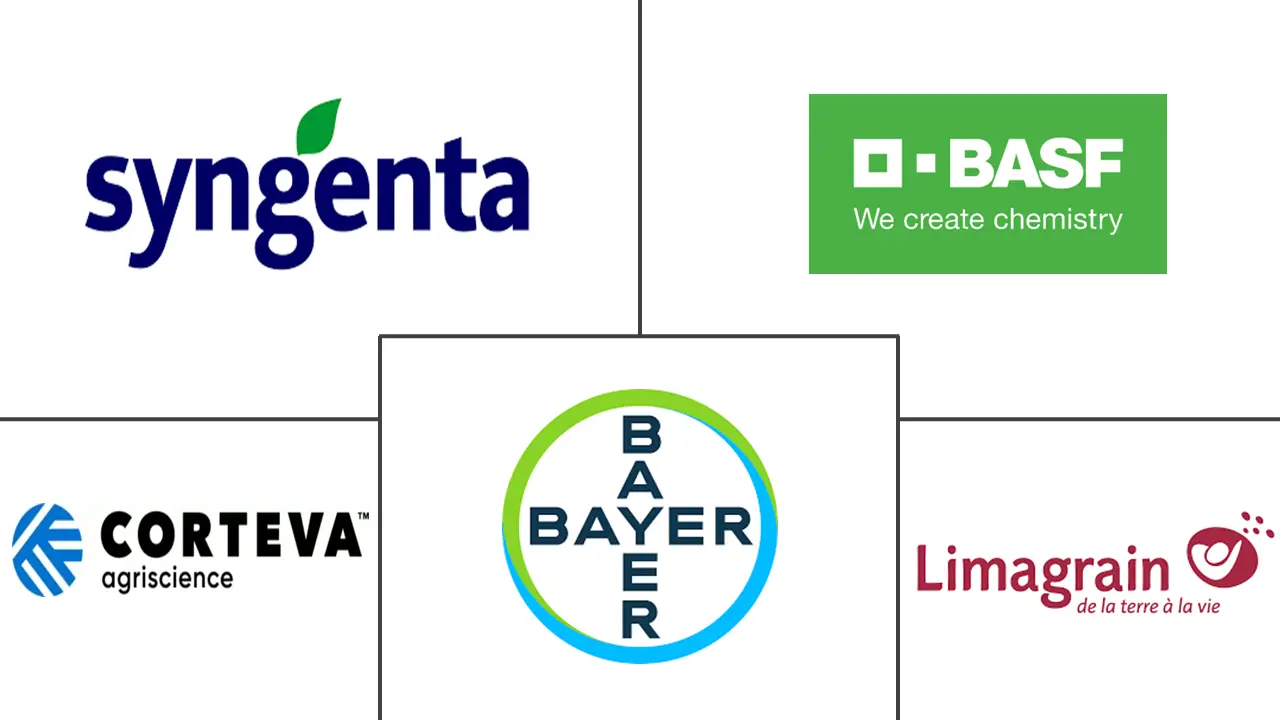Genetically Modified Seeds Market Size and Share
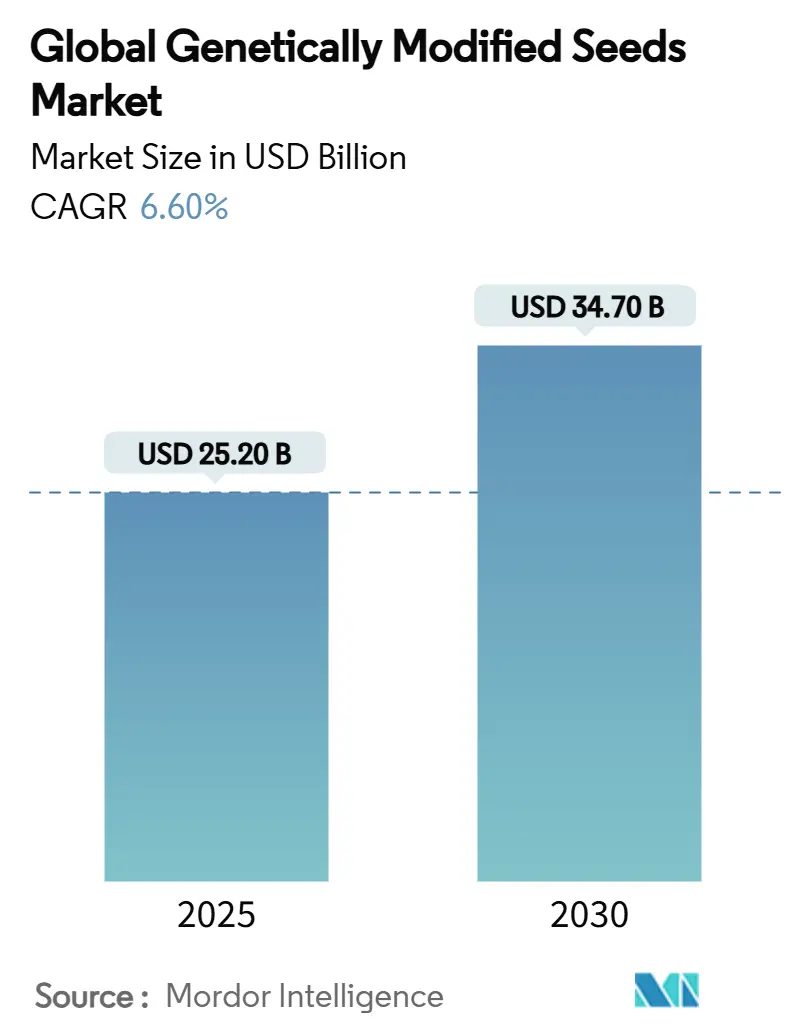
Genetically Modified Seeds Market Analysis by Mordor Intelligence
The genetically modified seeds market size is USD 25.2 billion in 2025 and is forecast to reach USD 34.7 billion by 2030, reflecting a 6.6% CAGR over the period. Continued farmer preference for stacked-trait hybrids, supportive approvals in China, and premium pricing opportunities for trait-enhanced cotton keep demand on a firm upward path. Scale advantages enjoyed by the top multinationals hasten global rollouts, yet patent expirations open space for regional breeders to license long-standing traits. Biological seed coatings, now bundled with leading corn and soybean brands, give seed companies fresh revenue lines while improving trait performance in the field. Finally, climate-resilient varieties tied to carbon-credit programs broaden the economic case for adoption in drought-prone regions.
Key Report Takeaways
- By crop type, corn held a significant share of 39% of the genetically modified seeds market in 2024, whereas genetically modified cotton is projected to grow with a CAGR of 9.8% during the forecast period.
- By trait, herbicide-tolerant hybrids led with a 42% share of the genetically modified seeds market size in 2024, while stacked-trait (cotton) is advancing at a 10.9% CAGR through 2030.
- By region, North America held 39% of the genetically modified seeds market share in 2024, whereas Asia-Pacific is projected to expand at an 8.7% CAGR to 2030.
- By competitive position, the five largest suppliers controlled 58.6% of the genetically modified seeds market size in 2024, creating a moderately concentrated field with room for regional specialists.
Global Genetically Modified Seeds Market Trends and Insights
Drivers Impact Analysis
| Driver | (~) % Impact on CAGR Forecast | Geographic Relevance | Impact Timeline |
|---|---|---|---|
| Seed–trait consolidation among multinationals | +1.2% | Global, strongest in North America and Europe | Medium term (2-4 years) |
| Rapid uptake of stacked-trait corn and soybean | +1.4% | North America, South America, and Asia-Pacific | Short term (≤ 2 years) |
| Relaxed gene-editing rules in China, Brazil, United States | +1.1% | Asia-Pacific, South America, and North America | Long term (≥ 4 years) |
| Biological seed coatings that boost trait expression | +0.9% | Global, early in North America and Europe | Medium term (2-4 years) |
| Climate-resilient GM seeds tied to carbon credits | +0.8% | Global and drought-prone regions | Long term (≥ 4 years) |
| Insect-resistant cotton for low-input systems | +0.7% | Asia-Pacific, Africa, and South America | Medium term (2-4 years) |
| Source: Mordor Intelligence | |||
Seed–trait consolidation among multinationals
Ongoing mergers integrate research pipelines, supply chains, and licensing groups, allowing companies such as Bayer AG to bring multi-trait hybrids to market faster and on a broader scale. Vertical ownership eliminates earlier bottlenecks where independent seed firms had to negotiate trait access, slicing one to two years off typical rollout times. Smaller breeders benefit, too, because standardized license pools reduce transaction costs and widen trait menus offered to farmers. The downside comes from antitrust scrutiny that may slow future deals, but the existing merger wave has already systematized global product launches. Consolidation also drives capital formation for next-generation gene-editing programs that require high fixed costs. As a result, R and D teams can bundle herbicide tolerance, insect resistance, and drought resilience into a single seed pack, supporting premium price points in the genetically modified seeds market. Investor pressure to monetize large patent estates further accelerates pipeline conversion to commercial lines.
Rapid uptake of stacked-trait corn and soybean
Stacked hybrids cut separate herbicide and insecticide passes, saving labor and fuel while preserving yields amid rising pest pressure. Brazil’s swift shift to Intacta2 Xtend soybeans, which are now on 30% of national acreage, illustrates the pull of in-field convenience and export contract compatibility. Seed companies capture a USD 15–25 per-acre technology fee, and farmers accept the premium as commodity prices reward dependable output. Grain originators increasingly mandate identity-preserved cargos bearing specific trait packages, pushing growers toward triple- and quad-stack solutions. In turn, developers are investing in even broader pest spectra, including RNAi-based rootworm protection, reinforcing the stack trend. Faster approvals in China mean the growing Asian demand for corn feedstock will also lean on these offerings, giving the genetically modified seeds market fresh volume headroom. The compounding effect on seed revenues is evident in the high single-digit CAGR for stacked-trait royalties worldwide.
Relaxed gene-editing rules in China, Brazil, and the United States
Clearer guidelines around CRISPR reduce regulatory drag, cutting time-to-market from roughly six years to under three in Brazil. China now exempts several gene-edited lines from full GMO review, so drought-tolerant and nutrient-enhanced crops can progress quickly to farmer trials. Because gene editing makes only minor edits without foreign DNA, some consumers view the products more favorably than classic transgenics, expanding potential acreage. The rule split lets developers segment portfolios: classic GM for complex multi-trait stacks and gene-edited varieties for incremental gains. Intellectual property strategies also shift, with companies filing defensive patents on guide RNAs instead of full insertion events. Over the long term, a steady flow of gene-edited traits should sustain CAGR momentum while diversifying revenue streams beyond the present herbicide-tolerance focus. The policy clarity likewise encourages venture investment into mid-size seed innovators targeting regional crops.
Climate-resilient GM seeds tied to carbon credits
Arcadia Biosciences secured United Nations approval for a methodology that links genetic improvements to verifiable carbon reductions, allowing farmers planting drought-tolerant lines to earn USD 20–30 per credit through programs such as Corteva’s Carbon Initiative. This link makes the seed purchase an entry pass to a secondary revenue stream, improving payback at the farm gate. In Argentina, blockchain tracking of HB4 wheat creates traceability for both yield and emissions outcomes, winning higher contract prices in export markets [1]Source: International Service for the Acquisition of Agri-biotech Applications, “Traceable Drought-Tolerant Wheat Products Set for Argentina, Brazil Consumers,” ISAAA.org . By combining agronomic resilience with environmental monetization, seed companies can command premiums even as commodity cycles soften. The model should scale in water-stressed belts of the United States Plains, Brazil’s Cerrado, and parts of India, adding growth legs to the genetically modified seeds market. Institutional investors targeting climate themes further channel capital into seed pipelines that carry clear emissions accounting frameworks.
Restraints Impact Analysis
| Restraint | (~) % Impact on CAGR Forecast | Geographic Relevance | Impact Timeline |
|---|---|---|---|
| Escalating patent and breeders’ rights litigation | −0.6% | Global, focus in North America and Europe | Short term (≤ 2 years) |
| Rising herbicide-resistant weeds | −0.8% | North America, South America, and Australia | Medium term (2-4 years) |
| Stringent GMO labeling mandates | −0.5% | Europe, Africa, and selected Asian markets | Long term (≥ 4 years) |
| Premium demand for organic and non-GMO foods | −0.4% | North America, Europe, and urban Asia-Pacific | Medium term (2-4 years) |
| Source: Mordor Intelligence | |||
Escalating patent and breeders’ rights litigation
A surge of lawsuits around expiring first-generation traits increases legal costs and delays launches for smaller companies that lack deep defense budgets. Complex stacking strategies often touch multiple patent estates, raising inadvertent infringement risk that can freeze regulatory dossiers until clearance is secured. Cross-licensing deals strike peace but may include territorial carve-outs, limiting competition in Asia or Africa. Farmer groups worry royalty layers will inflate seed prices, bringing political scrutiny that could reshape plant variety protection laws. Multinationals counter by accelerating R and D to new modes of action less exposed to litigation. Yet, interim uncertainty erodes CAGR contribution as wary breeders slow acreage rollout. Courts in the United States and Europe remain congested, so disputes drag on for years, tying up germplasm that could otherwise earn revenue in the genetically modified seeds market.
Rising herbicide-resistant weeds
Pigweed species such as Palmer amaranth and waterhemp now tolerate up to six herbicide groups in parts of the Midwest, eroding the farmer's return on glyphosate-dependent seed packages. Studies show cotton growers in India spend more on insecticides than before Bt adoption, underscoring resistance feedback loops. Developers respond with multi-mode-of-action tolerance, but each added trait raises discovery and regulatory cost, compressing margins. Weed resistance also revives interest in mechanical cultivation and cover crops, both of which lower demand for herbicide-tolerant hybrids. In export markets, residue limits tighten, pushing buyers to prefer grain grown under reduced chemical regimes, again trimming trait premiums. As resistance expands to South America and Australia, companies must invest in stewardship programs and new chemistries, diverting funds that could seed fresh genetic innovation.
Segment Analysis
By Crop Type: Corn Leads, Cotton Accelerates
Corn accounted for 39% of the genetically modified seeds market size in 2024, reflecting deep penetration across North and South America and a widening footprint in China. Stacked corn hybrids with herbicide tolerance, insect resistance, and drought resilience keep yields stable and simplify broadacre management. Soybean followed as Intacta2 Xtend in Brazil and Enlist E3 in the United States, pushing farm-level technology upgrades. Cotton demonstrates a 9.8% CAGR, the highest among major crops, as low-input regenerative schemes in India and the United States prefer insect-resistant lines. Minor crops such as canola hold 6% but anchor premium oils and omega-3 traits that fetch higher contract prices, extending the genetically modified seeds market share into food and industrial niches.
Over the forecast, cotton remains the pace setter as stacked insect-resistant traits converge with disease tolerance to cut spray costs. Corn advances through wider Chinese acreage and approval of large-scale, commercial planting of genetically modified (GM) crops, with the country approving 37 GM maize varieties in 2023 and 27 GM maize varieties in 2024 [2]Source: International Service for the Acquisition of Agri-biotech Applications, “China Shows Progress in GM Crop Approvals and Plantings”, ISAAA.org. Soybean growth hinges on new protein and herbicide combinations that address export buyer specifications. Specialty crops such as potato and eggplant grow from a small base but benefit from gene editing that navigates fewer regulatory steps, pulling incremental value into the genetically modified seeds market.
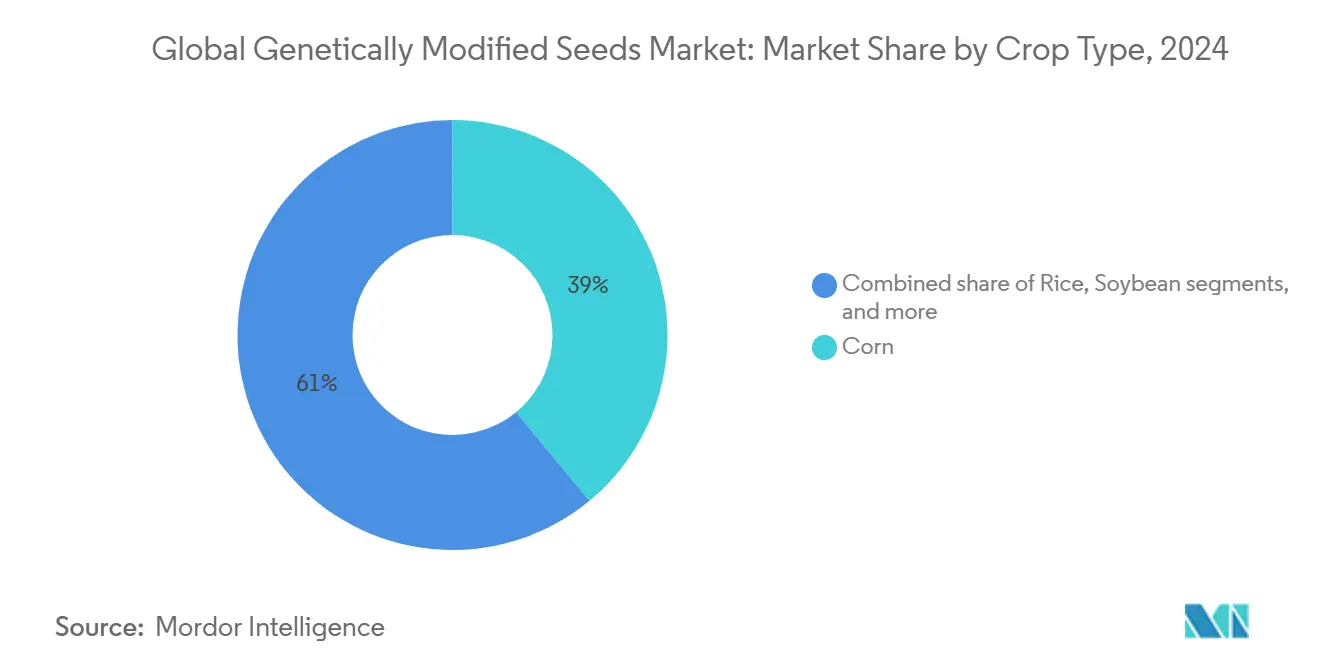
Note: Segment shares of all individual segments available upon report purchase
By Trait: Stacked-Traits Dominate the Growth
Stacked traits represent the fastest-growing bucket at a 10.9% CAGR, as growers see clear economics in single-bag convenience and broader pest coverage. Herbicide-tolerant hybrids still occupy the largest 42% genetically modified seeds market share, but mature markets like the United States show little acreage headroom. Insect-resistant lines capture 18.4% share, expanding in geographies where pesticide savings exceed trait fees, notably in cotton belts. Other traits, such as drought tolerance, disease resistance, and nutrition, show above-average growth because climate volatility makes risk-mitigation features more valuable.
The technology frontier now blends CRISPR edits with classic transgenic stacks, shortening development timelines and enabling precise expression control. Biological seed coatings further enhance stacked performance, potentially lengthening product life as regulatory scrutiny grows over chemistry-based crop protection. Combined, these innovations support sustained price premiums and help maintain the genetically modified seeds market size trajectory through 2030.
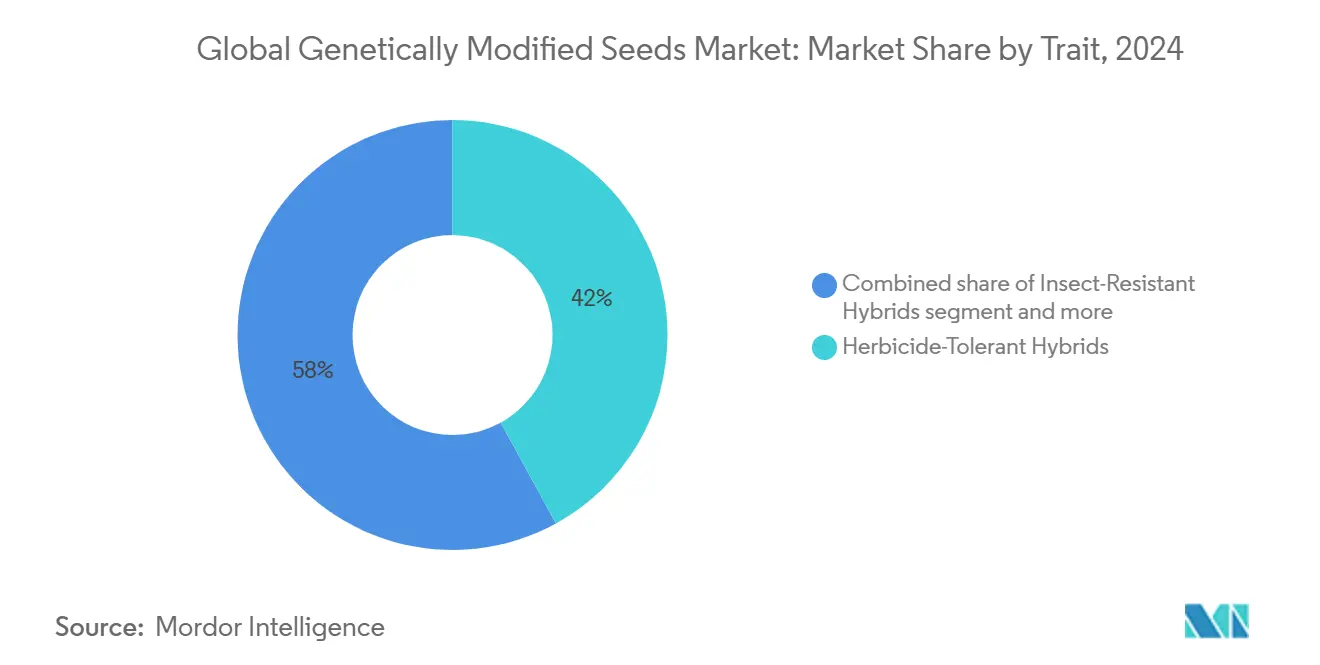
Note: Segment shares of all individual segments available upon report purchase
Geography Analysis
North America held a 39% share of the global genetically modified seeds market. This market leadership results from established regulatory approvals, high farmer adoption rates, and comprehensive trait licensing systems. The United States maintains GM crop cultivation across most of its corn and soybean acreage, providing consistent market revenues. Recent regulatory developments further strengthen the regional market, as evidenced by the 2024 approval of HB4 wheat, a drought-tolerant hybrid, making the United States the fourth country globally to approve its production [3]Source: Bioceres Crop Solutions, "Bioceres Crop Solutions Receives Green Light for Cultivation of Drought Tolerant HB4 Wheat in the United States", biocerescrops.com . The market benefits from premium pricing on stacked-trait seeds, which remains stable despite commodity price fluctuations, while emerging carbon-credit programs provide additional revenue opportunities for farmers. The harmonized regulations between the United States and Canada facilitate efficient seed distribution, and Mexico's evolving policies create new opportunities for GM corn hybrid adoption.
Asia-Pacific represents the most transformational outlook. China’s go-ahead for GM corn and soybeans sets the stage for multi-million-hectare uptake, adding significant volume to the genetically modified seeds market size. India, already a Bt cotton stronghold, is inching toward commercial GM mustard amid legal debates. Yet, enforcement gaps remain, as illegal GM maize detected in processed foods shows. Smaller Southeast Asian economies weigh food-security benefits against export concerns, so companies must craft localized communication and stewardship programs. Overall, the region’s 8.7% CAGR anchors the medium-term global growth narrative.
South America benefits from Brazil’s dynamic approvals and export-oriented farm structure. Rapid adoption of Intacta2 Xtend soybeans validates the farmer's appetite for technology that cuts passes and meets buyer mandates. Argentina’s blockchain-tracked HB4 wheat proves that climate-resilient traits can win consumer acceptance when traceability is transparent. Political alignment around agricultural competitiveness, combined with favorable agronomics, should keep the region’s CAGR ahead of the global mean.
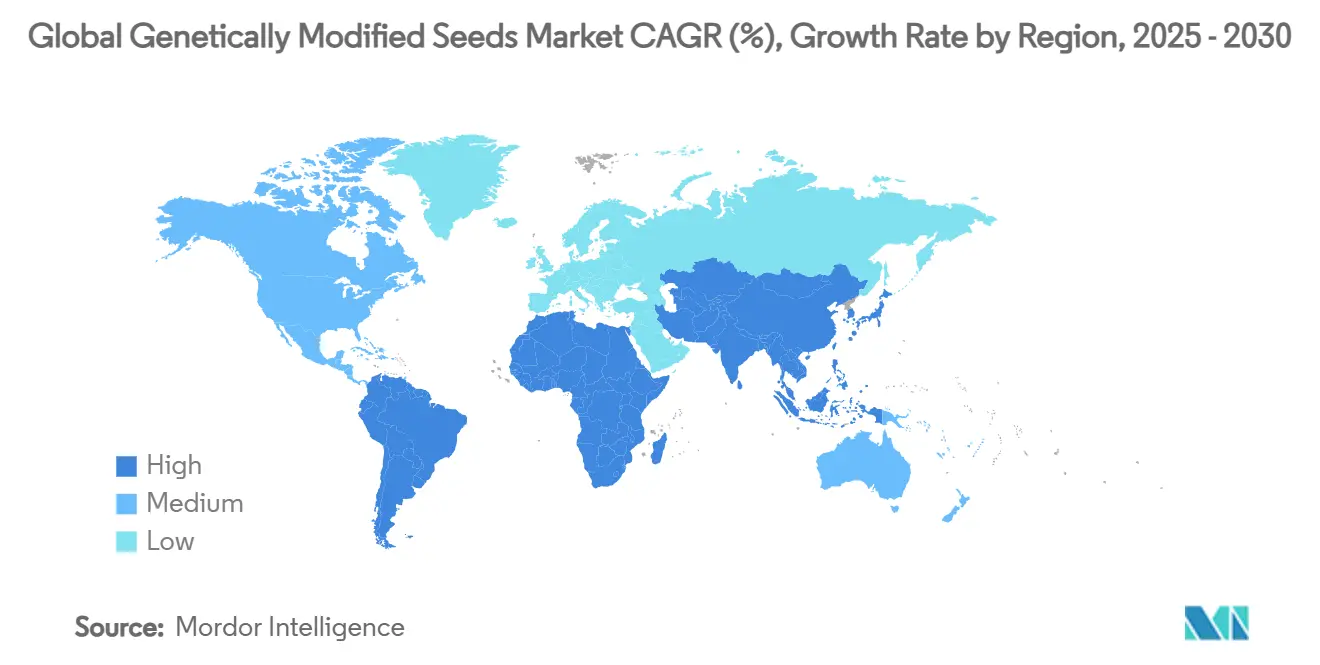
Competitive Landscape
Bayer AG, Corteva Agriscience, Syngenta AG, BASF SE, and Limagrain are the major players, collectively holding 58.6% of the genetically modified seeds market share, a level that implies moderate concentration. Bayer AG, leveraging integrated chemistry and seed offerings that bundle herbicide programs with multi-trait hybrids. Corteva Agriscience also occupied a significant market share, pushing digital agronomy platforms that use field data to reinforce seed-trait choices and loyalty. Syngenta’s expansion in Asia-Pacific complements its European presence, while BASF SE invests heavily in biological seed coatings to diversify revenue beyond genetic traits.
Strategic focus centers on patent portfolios, where cross-license deals secure stack components and block rivals. Large players also invest in proprietary distribution and farm-gate financing to lock in repeat sales. Regional challengers such as Yuan Longping High-Tech and Mahyco exploit local breeding expertise and government relationships to defend their home turf against multinational giants. Gene-editing alliances with research institutes aim to accelerate niche trait development without incurring full transgenic approval costs.
Mergers remain under antitrust watch, nudging firms toward joint ventures rather than outright acquisitions. Investment in supply-chain traceability tools grows, ensuring compliance with evolving export and labeling regulations.
Genetically Modified Seeds Industry Leaders
-
Bayer AG
-
Corteva Agriscience
-
Syngenta AG
-
BASF SE
-
Limagrain
- *Disclaimer: Major Players sorted in no particular order
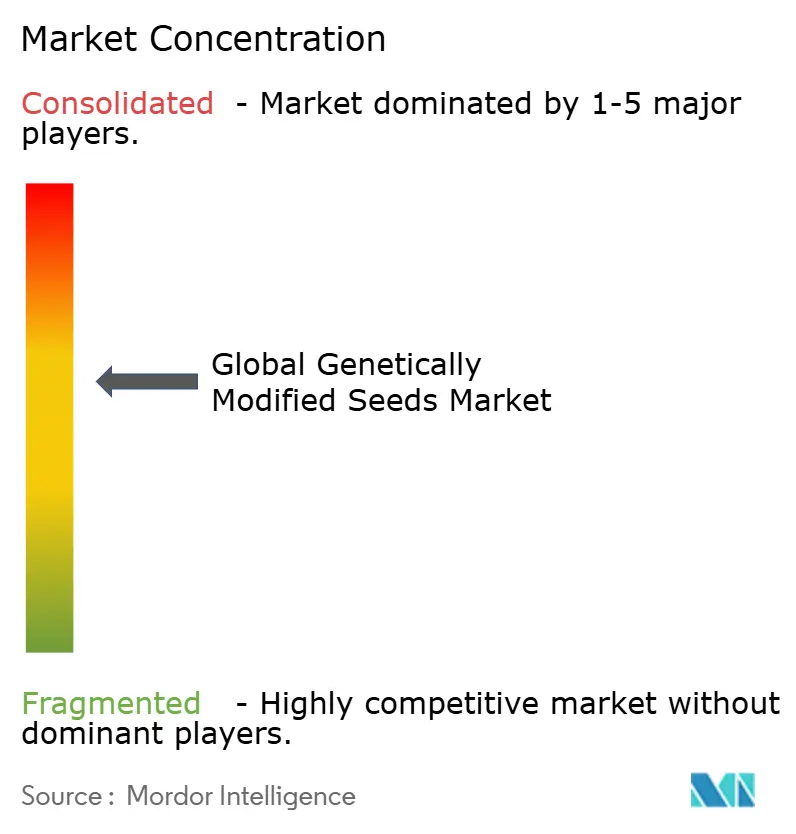
Recent Industry Developments
- August 2024: The United States Department of Agriculture has approved Bioceres Crop Solutions’ drought‑tolerant HB4 wheat after a Regulatory Status Review found it poses no increased plant‑pest risk. This decision, which aligns with a prior favorable FDA review for food and feed use, clears the path for United States cultivation.
- January 2023: Yuan Longping High-tech Agriculture in China has obtained biosafety certificates for its genetically modified (GM) corn and soybean seeds, enabling their commercial cultivation. The company developed the GM corn in collaboration with the Biotechnology Research Institute of the Chinese Academy of Agricultural Sciences. The modified corn demonstrates enhanced resistance to primary corn pests and tolerates glyphosate herbicide at four times the standard dosage. The GM soybean, developed by Hangzhou Ruifeng Bioscience, where Yuan Longping High-tech holds shares, features resistance to soybean pests.
- January 2023: JK Agri Genetics Limited introduced a new cotton hybrid, JKCH-9555, in the big boll segment. This hybrid is part of their efforts to expand their offerings in the cottonseed market, particularly in the central and southern cotton belts of India.
Global Genetically Modified Seeds Market Report Scope
| Rice |
| Corn |
| Soybean |
| Canola, Rapeseed and Mustard |
| Alfalfa |
| Cotton |
| Potato |
| Eggplant |
| Others |
| Herbicide-Tolerant Hybrids |
| Insect-Resistant Hybrids |
| Stacked Traits |
| Other Traits |
| North America | United States |
| Canada | |
| Mexico | |
| Rest of North America | |
| South America | Brazil |
| Argentina | |
| Rest of South America | |
| Europe | Spain |
| Portugal | |
| Romania | |
| Rest of Europe | |
| Asia-Pacific | China |
| India | |
| Japan | |
| Australia | |
| Rest of Asia-Pacific | |
| Africa | South Africa |
| Nigeria | |
| Egypt | |
| Rest of Africa |
| By Crop Type | Rice | |
| Corn | ||
| Soybean | ||
| Canola, Rapeseed and Mustard | ||
| Alfalfa | ||
| Cotton | ||
| Potato | ||
| Eggplant | ||
| Others | ||
| By Trait | Herbicide-Tolerant Hybrids | |
| Insect-Resistant Hybrids | ||
| Stacked Traits | ||
| Other Traits | ||
| By Region | North America | United States |
| Canada | ||
| Mexico | ||
| Rest of North America | ||
| South America | Brazil | |
| Argentina | ||
| Rest of South America | ||
| Europe | Spain | |
| Portugal | ||
| Romania | ||
| Rest of Europe | ||
| Asia-Pacific | China | |
| India | ||
| Japan | ||
| Australia | ||
| Rest of Asia-Pacific | ||
| Africa | South Africa | |
| Nigeria | ||
| Egypt | ||
| Rest of Africa | ||
Key Questions Answered in the Report
What is the current genetically modified seeds market size?
The genetically modified seeds market size is USD 25.2 billion in 2025 and is projected to grow to USD 34.7 billion by 2030.
Why are stacked traits growing so quickly?
Stacked traits combine herbicide tolerance and insect resistance in a single seed, cutting input costs and boosting convenience, which drives a 10.9% CAGR through 2030.
Which region shows the fastest growth?
Asia-Pacific leads with an 8.7% CAGR between 2025 and 2030, driven by China’s recent approvals for GM corn and soybean.
What major challenge could slow market growth?
The rapid spread of herbicide-resistant weeds threatens the profitability of herbicide-tolerant traits, pushing developers to invest in new mechanisms and stewardship programs.
Page last updated on:
